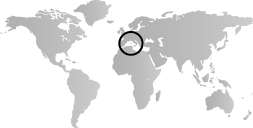In 1800, most of present-day Italy is united as the Cisalpine Republic under French rule, while the Iberian Peninsula, also under the yoke of Napoleon, is torn by war with its occupying forces. After Napoleon’s fall in 1814, earlier political boundaries are largely restored. This results in a wave of Italian nationalism that culminates in the country’s unification in 1861. Various movements in the arts—including revivalist styles that celebrate the Italian artistic legacy and, later, schools of realism—reflect an interest in national identity. The Iberian Peninsula remains a seat of political unrest throughout the period. At the century’s end, however, the Catalan region of Spain emerges as a major center of modernism in literature, the visual arts, and, above all, architecture.
Meanwhile, Russia’s influence in various parts of the Ottoman empire extends to the Balkan Peninsula, where it supports a number of independence movements in the Ottoman provinces of the region. The British also become involved; their plan to weaken the monolithic empire results in the independence of Greece and greater rights for Bulgaria and Serbia, though the latter remain under Ottoman rule.


